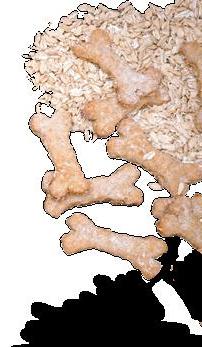
4 minute read
natural pet
Doggy Delights
Healthy, Homemade Cookie Treats
by Amy Coyle
One morning, Randy Roach awoke to a delicious aroma wafting from the kitchen of his Philadelphia home. Mouth watering, he peeked in the oven to find a dozen bone-shaped cookies—meant not for him, but for Woods, the family dog. “Such is life when you live with a dog lover,” laughs Randy’s wife Kate, who had peanut butter, oat and flax seed cookies baking for their rescued Labrador mix, a picky eater.
Cooking treats for canine family members is a smart move, as they are eco-friendly, cost less and are healthier than company-made ones, say veterinarians.
A Smaller Pawprint
With the focus on decreasing personal carbon footprints, an Earth-conscious dog owner may want to make dog biscuits at home purely for the lower environmental impact. Research from UCLA shows that industrial production of dog and cat food creates the equivalent in greenhouse gases of 13 million cars annually. Store-bought dog treats require oil, energy and water to produce and transport. The packaging often contains plastic or other non-biodegradable materials, which cause pollution, block drains and harm wildlife. Making treats at home is simple and less tricky nutritionally than making a dog’s regular meals. “When it comes to regular dog food, I’m not a proponent of home-cooked food. It is far too difficult to balance nutrients. For treats, I am not so concerned,” says Lawrence Gallagher, VMD, at Villanova Vet, in Villanova, Pennsylvania. “But you need to watch calories. Treats should be ‘high-reward’ and low-calorie, not necessarily big in size. They are used as a reward, not to fill the stomach.” Homemade dog treats cost less over time. Many popular traditional dog treats are $5 to $10 per bag, with organic costing more. Kate figures she saves as much as $20 a month making Woods’ treats.
A Healthy Choice
The labels on many commercial dog treats list dubious ingredients such as meat by-products, sugar, sodium metabisulfite (a bleaching agent), propylene glycol and artificial colors. “My general rule of thumb is if you cannot pronounce or don’t recognize an ingredient, it is probably not healthy for your pet,” says Alison Streit Birken, DVM, owner of Victoria Park Animal Hospital, in Fort Lauderdale.
In addition, some packaged treats are produced in countries where ingredient and manufacturing regulations are less rigorous, which has led to illness and even death in dogs.
Getting Started
No special equipment is required. Mixing bowls, measuring spoons, a wooden spoon, baking sheets and a cooling rack will suffice. More ambitious treat-makers might want a muffin pan for custom shapes. Common ingredients include pumpkin, bananas, yogurt and peanut butter. When choosing a recipe, aim for no or little sugar. (Honey and molasses are simple sugars.) Also, because homemade treats have no preservatives, be sure to follow storage requirements such as refrigeration or freezing.
Jen Jovinelly, a DVM candidate at the Cornell University College of Veterinary Medicine, promotes simple treats. “Treats are not food. Keep the caloric intake from treats under 10 percent of your dog’s daily caloric requirement.” She also cautions to avoid foods that could be dangerous, such as chocolate, grapes, raisins, avocados, certain nuts, onions, garlic or artificial sweeteners. If unsure about the safety of an ingredient, check the online list at The Humane Society of the United States (HumaneSociety.org) or consult with a veterinarian or animal nutritionist.
For those that aren’t inclined to bake, toys filled with organic peanut butter, then frozen, keep dogs happy, while others love the crunch of raw carrots or broccoli. As Birken says, “You can always go to your own refrigerator and pick out some great, healthy dog treats!”
Amy Coyle is a freelance writer in Wynnewood, Pennsylvania.
Good Dog Treat
Yield: varies

1 15-oz can pumpkin ½ cup peanut butter ½ cup coconut oil, melted 4 (organic, cage-free) eggs 1¾ cups coconut flour Preheat oven to 350° F. In a large bowl, whisk together pumpkin, peanut butter, coconut oil and eggs until smooth. Add coconut flour. Mix until well combined. Let rest for 5 to 10 minutes to thicken. Place dough in between two pieces of parchment paper and roll the dough until it’s about one-quarter-inch thick. Remove the top layer of the parchment paper and cut shapes with cookie cutters (consider the size of the dog when selecting cutter sizes). Bake for 45 to 55 minutes until treats are dry and hard. Let cool completely. Store in an airtight container.
Courtesy of Kate Roach.
Kate’s PB Oat Cookies
Yield: 24 dog treats
1 cup peanut butter ½ cup rolled oats 2 Tbsp flaxseed Water, as needed Grind flaxseed to powder in a food processor or coffee grinder. Combine flaxseed, oats and peanut butter, adding just enough water to make a dough. Roll into 24 balls and chill in sealed container in refrigerator for 30 minutes. Place on a cookie sheet, evenly spaced, and bake at 350° F for 15 minutes.
Courtesy of Kate Roach.
Feel the JOY of LOVE again!
Join the Largest Online Community of Holistic-Conscious Singles who value
Authentic & Loving Relationships Natural Health & Sustainable Living Living a Conscious Life Honoring Diversity






